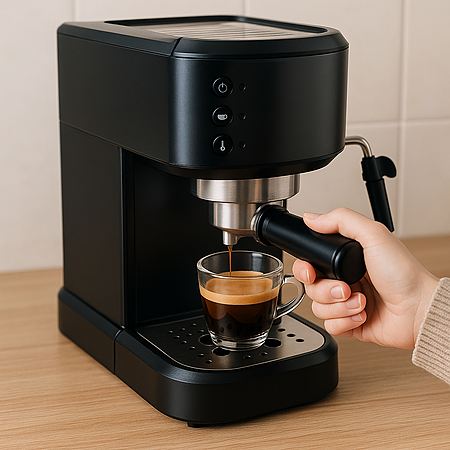An espresso machine is a powerful tool for making rich, concentrated coffee with a velvety crema. Unlike drip coffee makers, it uses high pressure to extract bold flavors from finely ground beans, creating the foundation for drinks like lattes, cappuccinos, and Americanos. While high-end machines offer advanced features, the core principles of pulling a great shot remain the same—using the right grind size, dose, and tamping pressure to achieve a balanced extraction.
Learning to use an espresso machine takes practice, but understanding the fundamentals will set you up for success. From dialing in the perfect grind to steaming silky milk for lattes, each step plays a crucial role in achieving café-quality results. This guide will walk you through the essential techniques, helping you avoid common pitfalls and refine your skills for consistently great espresso.
What You’ll Need:
- Espresso machine
- Towel
- Burr grinder (or coffee pre-ground for espresso)
- Coffee beans or coffee ground for espresso
- Espresso tamper
- Food scale
- Timer
- Espresso cup or ceramic mug
How to Use an Espresso Machine: Step by Step
Step 1: Clean the portafilter
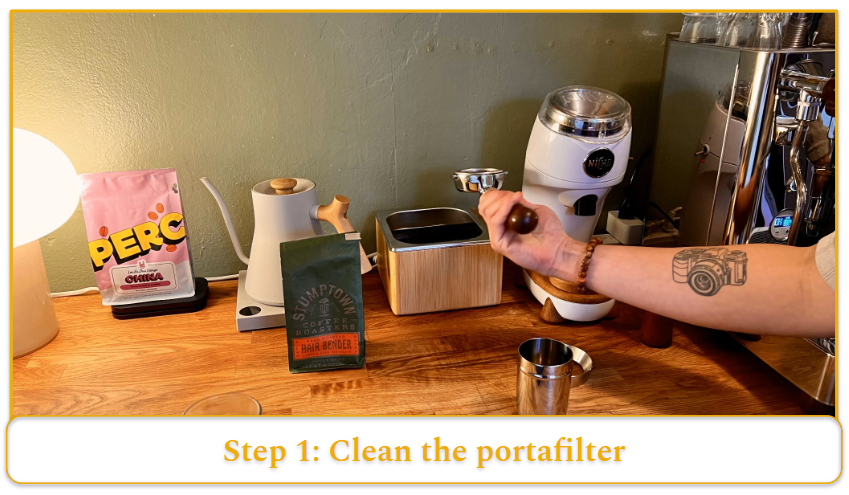
Take the portafilter out of the espresso machine and wipe the basket dry with a towel.
Step 2: Grind the coffee and add it to the basket
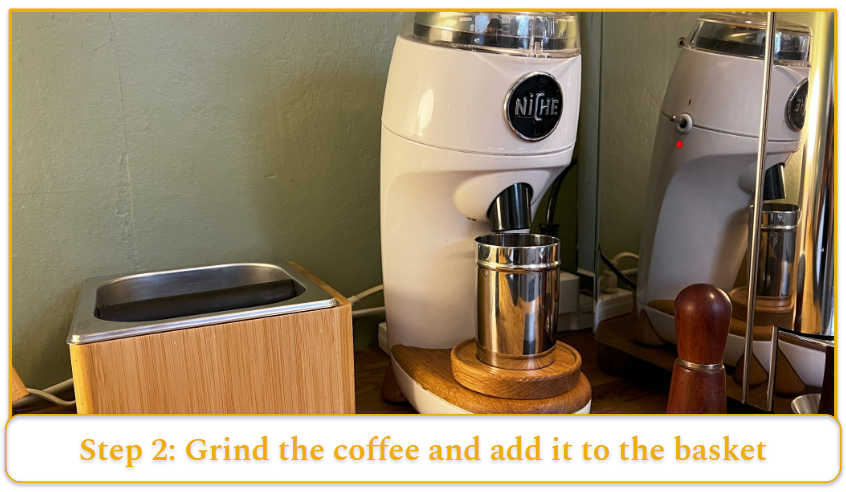
Finely grind 18-20 grams of coffee, or add about 2 tablespoons of espresso-ground coffee to the basket. It should be the consistency of sand. If you have a scale, you can also weigh this amount with your portafilter on top of the scale after taring it.
Step 3: Level out the grounds and press onto them
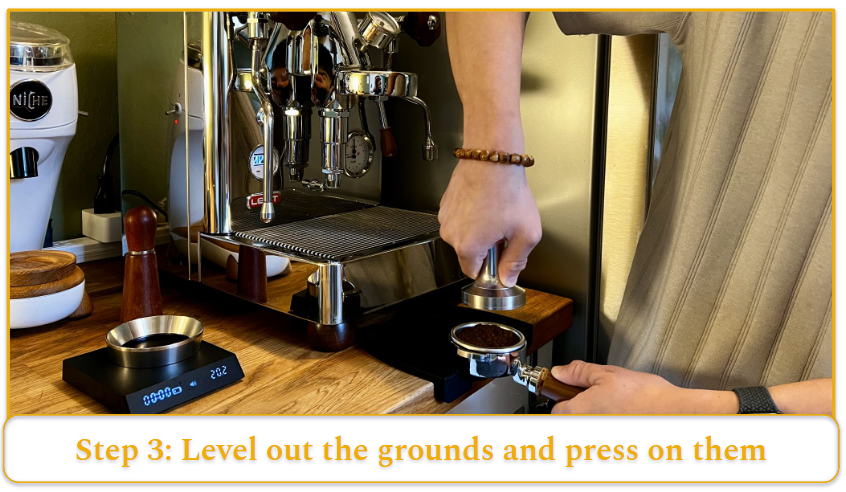
- Give the portafilter a loose shake in order to level out the grounds inside the basket.
- With your espresso tamper, press onto the coffee grounds firmly and evenly until you feel a slight resistance pushing back.
Step 4: Start brewing
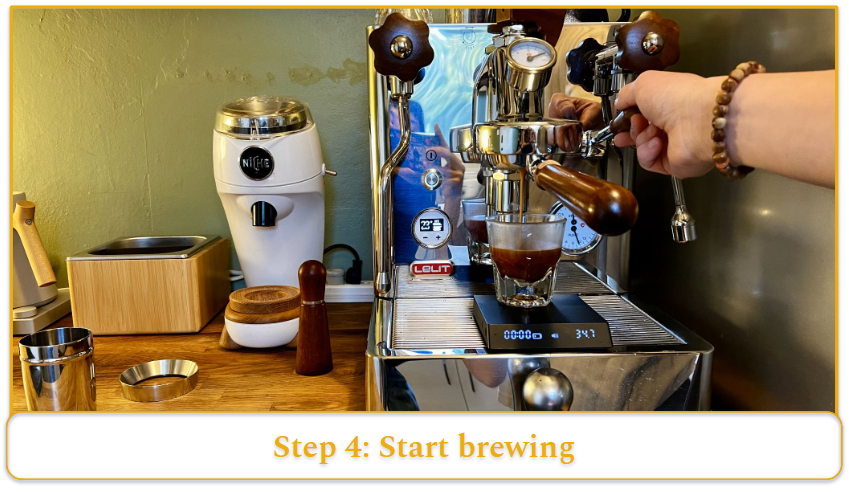
- Gently twist the portafilter back into the espresso machine until it fits snugly.
- Place the mug underneath it on top of the espresso tray.
- Press the button labeled for a double shot. Start your timer when you press the button.
Step 5: Stop brewing

- After 25-30 seconds press the button again to stop brewing.
- Your espresso shot should have yielded around 30-40 grams of espresso, which you can weigh on the scale to check.
Step 6: Take out the portafilter and clean it
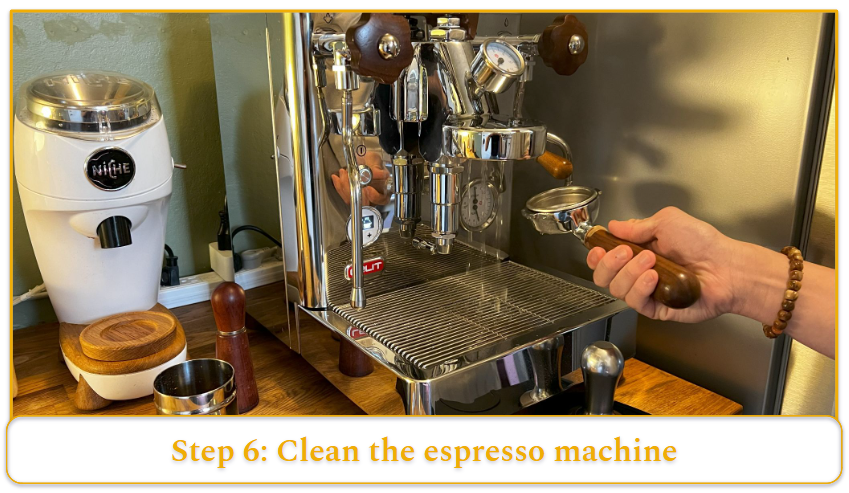
Take the portafilter out of the espresso machine once again to knock out the used espresso puck. Wipe the portafilter with a towel and place it back in the machine.
How to Steam and Froth Milk With an Espresso Machine
The difference between steamed milk with an espresso machine and a milk frother is big. While a milk frother swirls milk into a whirlpool to heat it, a steam wand incorporates high-pressure steam into the milk, resulting in a creamier, velvet-textured drink. Here’s how to steam milk for a latte.
What You’ll Need:
- Stainless steel pitcher
- Espresso machine with a steam wand
- Towel
- Milk of choice
Step 1: Prepare the steam wand
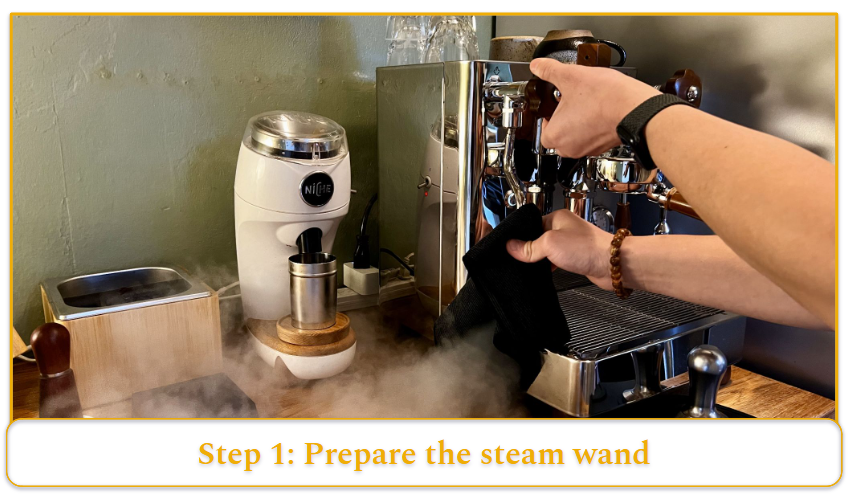
Prepare the steam wand for use. While loosely covering the tip of your steam wand with a damp towel, turn the knob on for 2-3 seconds to remove water buildup from the bottom.
Step 2: Fill your pitcher with milk
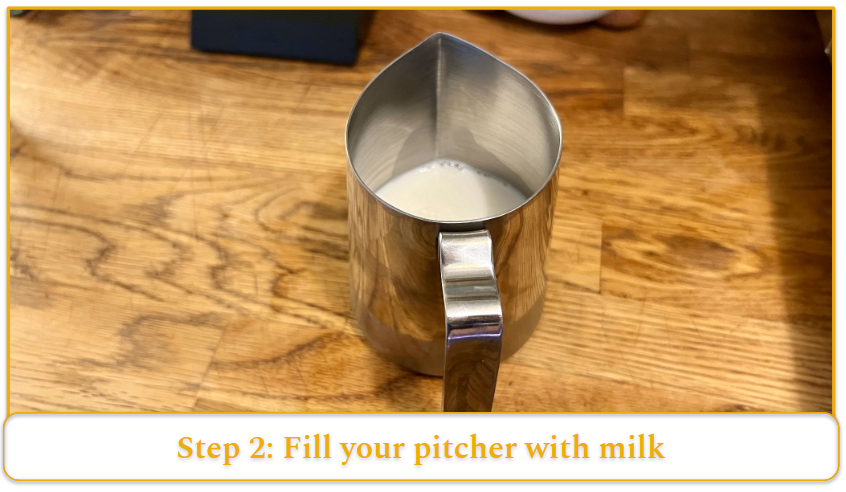
Fill your pitcher with enough milk till it reaches the bottom of the spout.
Step 3: Position your pitcher and steam wand
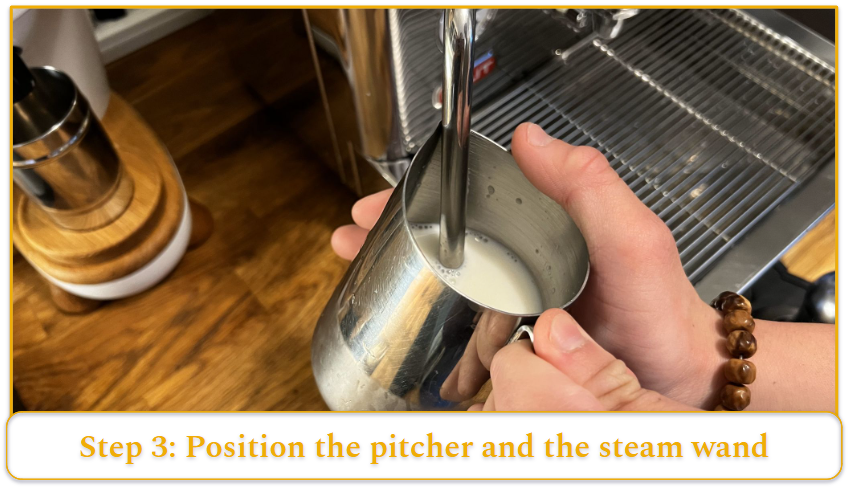
- Tilt your pitcher till the bottom of your steam wand is halfway submerged in the milk at a diagonal angle, resting along the spout.
- Turn on the knob, then lower your pitcher enough so that the steam wand is slightly exposed to incorporate air into the milk to steam.
- Do this for 1-2 seconds before re-submerging the wand. This will prevent a screeching sound commonly heard in beginning milk steaming.
Step 4: Steam the milk
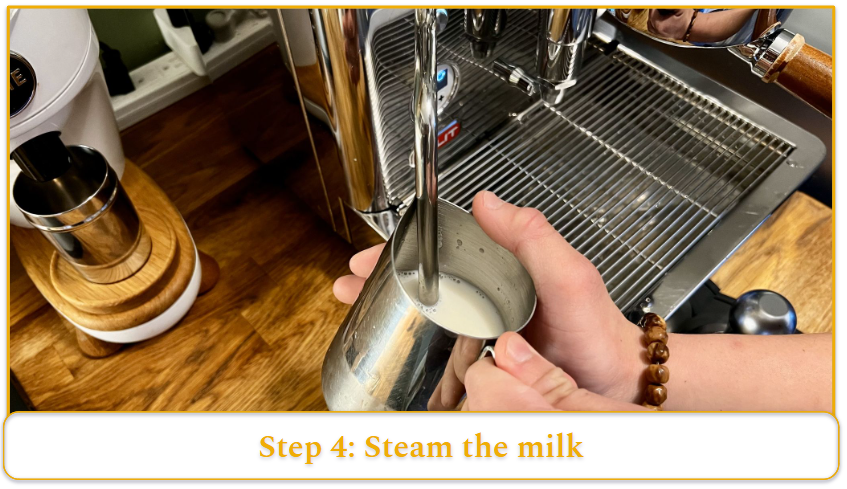
- You should begin to see a whirlpool forming inside the pitcher.
- While this is happening, use one hand to continue holding the pitcher diagonally by its handle as it’s steaming.
- Use the other hand to lightly tap the outside of the pitcher to assess how hot it is. Typically, the milk is ready for a latte when it is too hot to touch.
- Optionally, you can add a thermometer to the pitcher to watch it reach 65-70 degrees Celsius.
Step 5: Clean the steam wand
- Turn off the knob and remove the pitcher from the steam wand.
- Use the same damp towel to wipe any milk residue from the steam wand.
- Turn the knob once more for 1-3 seconds to remove milk from the inside of the wand.
How Does an Espresso Machine Work?
An espresso machine uses high pressure to force hot water through a tightly packed bed of coffee, which creates a concentrated coffee beverage.
Inside every espresso machine is a water reservoir that doubles as a water boiler. If the machine is for commercial use, it’s connected to a water line that will consistently replenish water in the boiler. An electric pump system will pressurize this water and push it through the machine into the water boiler. The boiler will then heat it to an optimal temperature of 92-96 degrees Celsius.
From there, the hot water travels to either the steam wand or the grouphead, where the portafilter (with coffee) is located. The coffee inside the portafilter is finely ground and tightly packed, which creates additional pressure.
When you push one of the espresso shot buttons of the machine, the opening to the grouphead will allow the pressurized water to pass through this coffee bed. The water will extract the flavors from this coffee in a concentrated amount, resulting in your coffee beverage.
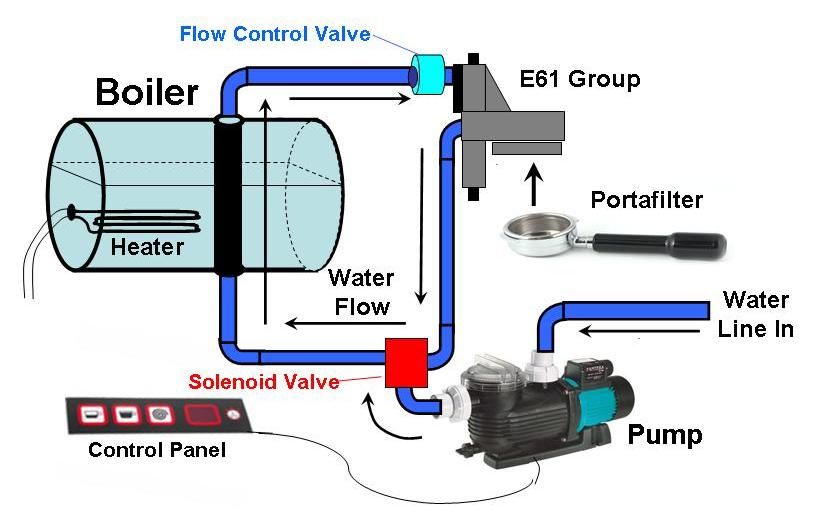
How to Make the Most of Your Espresso Machine
Espresso machines create cafe-quality brews from the comfort of home. However, it is important to maintain them just as often as a cafe would. This means frequent cleaning, and sometimes even the occasional replacement of certain parts.
Keep your machine clean
Over time, finely ground coffee accumulates throughout the machine, from the buildup the coffee oils create to grounds becoming trapped in the water inside the machine.
Here’s what to do to prevent this buildup:
- Don’t leave used coffee pucks sitting inside the portafilter after brewing
- Wipe the portafilter clean with a towel after you take out the coffee puck.
- Flush the grouphead by running shots of just hot water before and after use.
- Use filtered water to prevent limescale on heating elements.
- Descale your espresso machine occasionally (with special cleaning tablets).
- Backflush the machine once a week. Do this by starting a brew (just water) while using a blind basket (with no holes on it).
Change out parts
Regular maintenance ensures your espresso machine functions properly and lasts longer. Some parts wear out over time and should be checked and replaced as needed.
- Gasket (Portafilter Seal). This is a rubber ring inside the portafilter that seals it to the grouphead. Hot water degrades it over time, leading to leaks and difficulty securing the portafilter. Signs of wear include leaking, difficulty attaching the portafilter, or a hardened gasket. You should replace it every 6 to 12 months, depending on usage.
- Water Filter. Located inside the water reservoir, it helps prevent scale buildup and improves water quality. You should replace it every 3 to 6 months, depending on how often you brew.
- Grouphead, basket, and screws. These parts may wear out or break over time, affecting espresso quality and machine performance. Regularly inspect them and replace as needed.
Simple Espresso Recipes Others Love
How to make a latte
- Fill your choice of milk to just below the bottom of the spout in a 12-ounce milk pitcher.
- The milk will expand when you heat it.
- Steam the milk to 65-70 degrees Celsius, or until the pitcher is too hot to touch.
- Add the milk to a double shot of espresso in a mug.
How to make a cappuccino
Cappuccino comes in two forms.
- For those who prefer a wet cappuccino (wet meaning less foam), steam your choice of milk in a 400-ml pitcher, or leave around one inch of milk below the spout of a 12-ounce pitcher.
- Steam to 55-65 degrees Celsius. Add to a double espresso shot in a mug.
- If you prefer a dry (foamier) cappuccino, expose your steam wand to air periodically while steaming to generate the amount of foam to your preference.
- Resubmerge the wand when you have enough foam.
- Add milk and foam to a double shot of espresso.
How to make a macchiato
- Add enough milk to your pitcher to submerge the tip of your steam wand.
- Steam to 60 degrees Celsius.
- You want the milk to be warm, not hot.
- If you prefer a foamier macchiato, repeat the same technique of exposing your steam wand to air to generate foam, then add milk to a double shot of espresso in a small cup.


